Parma is a city located in northern Italy, known for its rich history and culture. It is also home to a wide variety of birds. From the majestic eagles soaring through the sky to the small sparrows flitting about the city streets, Parma is a haven for birdwatchers.
The surrounding countryside provides a habitat for a variety of species, from the common blackbird to the rare Golden Eagle. Birdwatchers can explore the city and surrounding areas to observe these birds in their natural habitats.
With the right knowledge and dedication, birdwatching in Parma can be an enjoyable and rewarding hobby.
1. Rock Dove
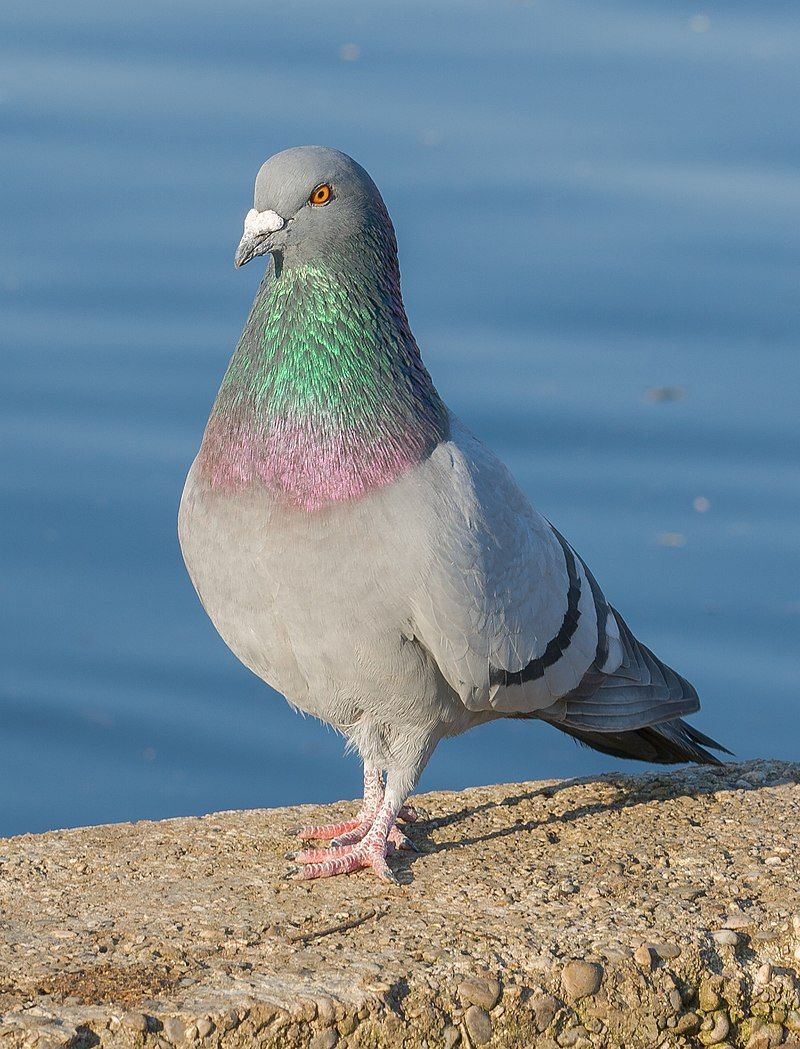
The rock dove, also known as the rock pigeon or common pigeon, is a species of bird belonging to the family Columbidae. It is a widespread species, found in cities, towns, and rural areas, and is often simply referred to as the “pigeon”.
The domestic pigeon is a descendant of this species, and as a result of domesticated pigeons escaping and establishing feral populations, the species can now be found in many parts of the world.
Feral pigeons are those that have either escaped from captivity or are the descendants of escaped birds. They can be found in parks, gardens, and other urban areas. They are able to survive in a wide range of habitats, making them widespread and often abundant.
The rock dove is a hardy species, and its ability to adapt to urban environments has made it particularly successful.
| Kingdom | Animalia |
| Phylum | Chordata |
| Class | Aves |
| Order | Columbiformes |
| Family | Columbidae |
| Genus | Columba |
| Species | C. livia |
2. Little Grebe
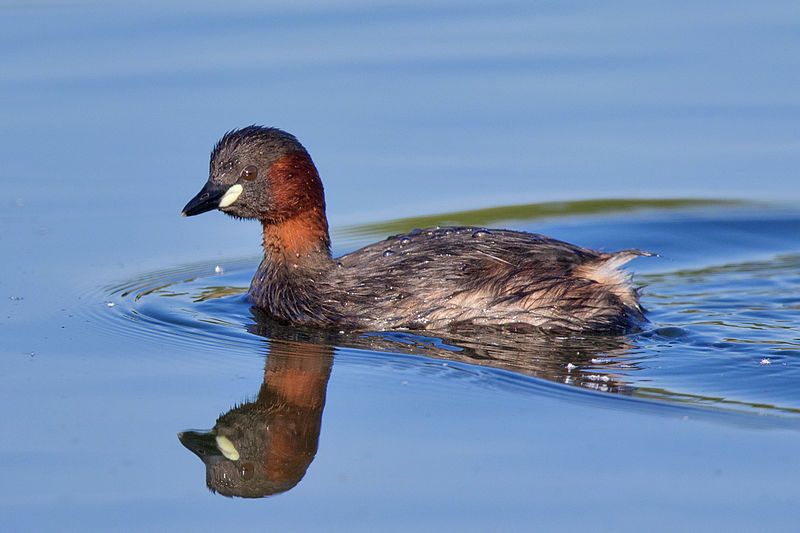
The little grebe, also known as dabchick, is a small water bird belonging to the Grebe family. The genus of this species, Tachybaptus, is derived from Ancient Greek, with “takhus” meaning “fast” and “bapto” meaning “to sink under”.
The specific name, ruficollis, is Latin in origin, with “Rufus” meaning “red” and “Collis” meaning “necked”. This is indicated by the Modern Latin suffix “-Collis”, which is derived from the Latin word “collum”, meaning “neck”.
This refers to the reddish-brown color of the neck of the little grebe.
| Kingdom | Animalia |
| Phylum | Chordata |
| Class | Aves |
| Order | Podicipediformes |
| Family | Podicipedidae |
| Genus | Tachybaptus |
| Species | T. ruficollis |
3. Mallard
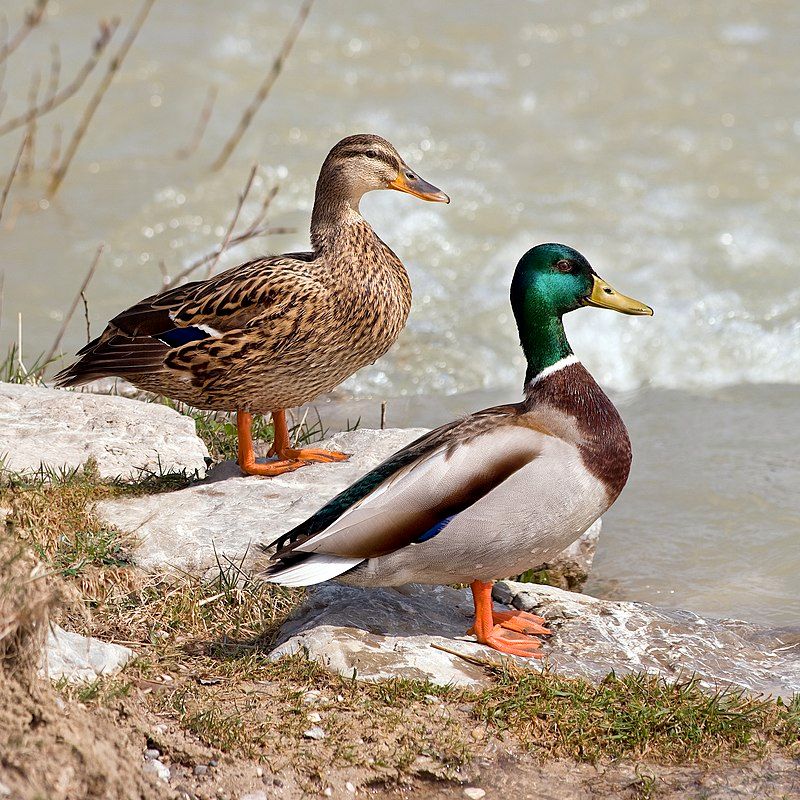
The mallard or wild duck is a species of dabbling duck that is found throughout much of the world. These ducks breed in temperate and subtropical regions, including parts of the Americas, Eurasia, and North Africa.
In addition, the mallard has been successfully introduced to other regions, such as New Zealand, Australia, Peru, Brazil, Uruguay, Argentina, Chile, Colombia, the Falkland Islands, and South Africa.
This introduction has allowed the mallard to expand its range to include a wide variety of habitats, from wetlands to grasslands. The mallard is a medium-sized duck and is easily recognizable due to its distinctive plumage.
Males are generally a bright greenish-brown color, while females are a duller brown. Both sexes have a white chest and black and white striped wings.
Mallards are also known for their loud quacking call. The mallard is an omnivore and will eat a wide variety of foods, including aquatic plants, insects, and small fish. They often feed in shallow water, upending in order to reach food on the bottom.
During the breeding season, the mallard will form small flocks and can often be seen in wetlands and other aquatic habitats. The mallard is an adaptable species and is classified as a species of least concern by the IUCN.
Although populations have declined in some areas due to habitat loss, hunting, and other human activities, the mallard has been able to thrive in many areas thanks to its wide range and ability to adapt to different habitats.
| Kingdom | Animalia |
| Phylum | Chordata |
| Class | Aves |
| Order | Anseriformes |
| Family | Anatidae |
| Genus | Anas |
| Species | A. platyrhynchos |
4. Northern Shoveler
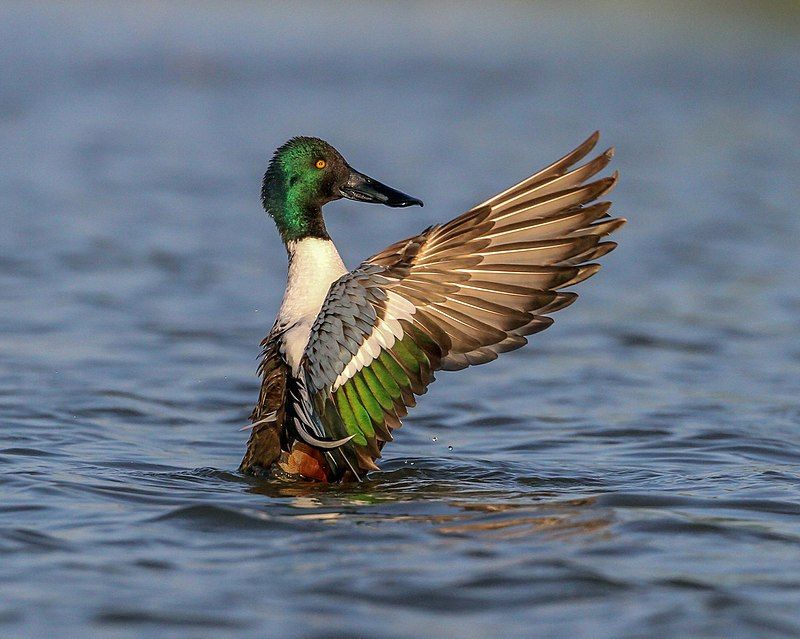
The northern shoveler, also known as the shoveler, is a widely distributed duck species. Its typical breeding habitats are in the northern regions of Europe, and across the Palearctic, which includes most of North America.
During the winter season, this duck migrates to more southern areas, including southern Europe, the Indian Subcontinent, Southeast Asia, Central America, the Caribbean, and northern South America.
The northern shoveler is a medium-sized duck, reaching an average weight of around 500 grams in adulthood. Its body is predominantly brown in color, with a long, broad bill that is yellow on the sides and black on the tip.
Its head is mottled with white and gray feathers, while its back and wings are a plain brown. Its feet are orange, with a white patch on the tips of its wings. The northern shoveler is a highly social bird, usually seen in large flocks of 20 or more birds.
During the breeding season, it will form monogamous pairs and establish nesting territories. It feeds mainly on aquatic insects and vegetation and can be seen dabbling in shallow waters or grazing near shorelines.
The northern shoveler is an important species for conservation, as it provides ecosystem services such as nutrient cycling and pest control. It is vulnerable to habitat loss and degradation, so it is important to ensure that suitable habitats are preserved and protected.
| Kingdom | Animalia |
| Phylum | Chordata |
| Class | Aves |
| Order | Anseriformes |
| Family | Anatidae |
| Genus | Spatula |
| Species | S. clypeata |
5. Great Crested Grebe
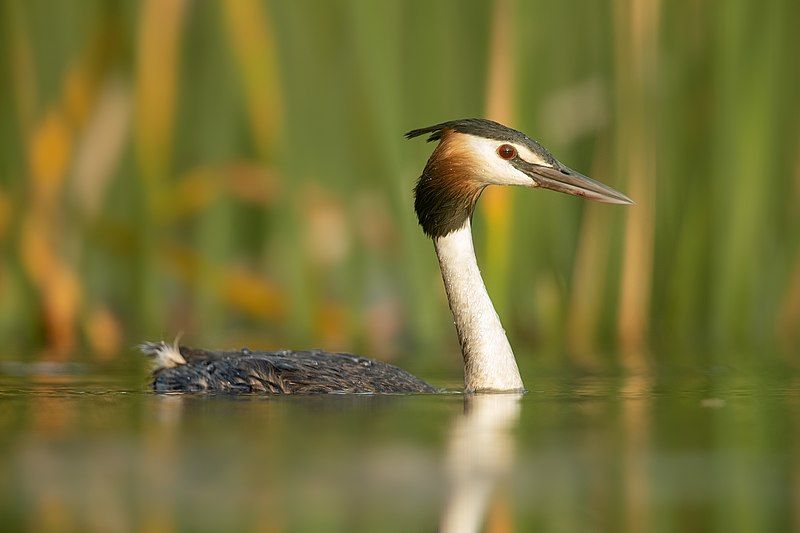
The great crested grebe is a species of water bird belonging to the grebe family. It lives in temperate regions throughout Europe and Asia, as well as in parts of Africa. They can be found in various freshwater habitats, such as lakes, ponds, and marshes.
The great crested grebe is known for its stunning mating display. During the spring and summer months, they perform a ritual of courtship which includes synchronized swimming and elaborate head-shaking movements.
In this ritual, they swim side by side, dipping their heads and shaking them in a synchronized manner. This display is believed to be designed to attract a mate. The great crested grebe also has a unique call that is used by males to attract the attention of females.
The call consists of a series of high-pitched whistles that can be heard from a distance. The courtship rituals of the great crested grebe are fascinating and unique and serve as a reminder of the beauty of nature.
| Kingdom | Animalia |
| Phylum | Chordata |
| Class | Aves |
| Order | Podicipediformes |
| Family | Podicipedidae |
| Genus | Podiceps |
| Species | P. cristatus |
6. Eurasian Teal
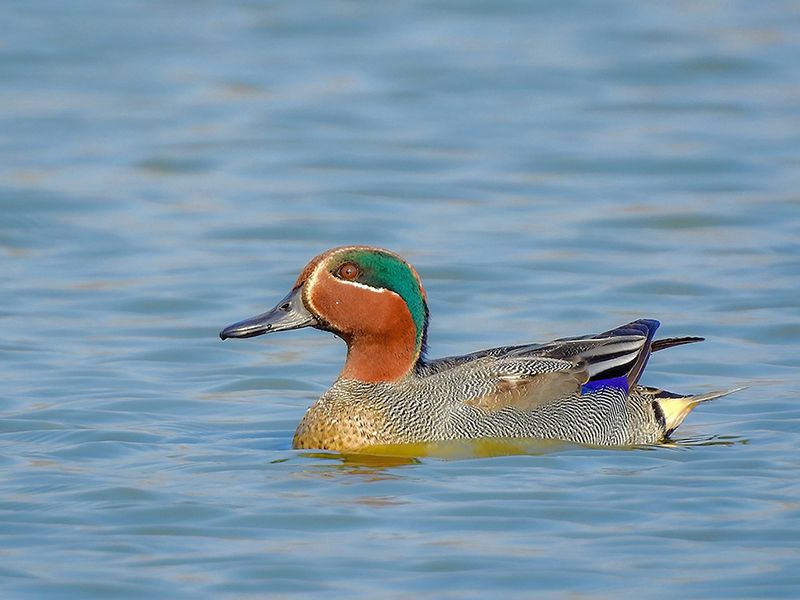
The Eurasian teal, also known as the common teal or Eurasian green-winged teal, is a species of duck that is found in temperate Eurasia and Siberia.
Its range is extensive, and it is the only species of small dabbling duck in much of its range, hence why it is simply referred to as the teal.
The Eurasian teal is a common and widespread duck that breeds in these regions during the summer months and then migrates south to warmer climates during the winter.
The Eurasian teal is a small duck, measuring approximately 16-19 inches in length and typically weighing between 11-20 ounces. Its feathers are a vibrant green/blue color with a white and black head and neck.
The wings of the Eurasian teal are distinguished by a green patch and white-tipped feathers. The Eurasian teal is a dabbling duck, meaning it feeds by tipping its head upside-down and submerging its bill into the water in order to filter out food.
It has been known to feed on a variety of aquatic insects, molluscs, aquatic plants, and seeds. The Eurasian teal is a highly adaptable species and can be found in a variety of habitats, including marshes, wetlands, lakes, ponds, and rivers.
The Eurasian teal is a popular species for hunters and is considered to be a game bird. It is also a popular species for birdwatchers and is often seen in large flocks, providing an excellent opportunity to observe their behavior.
The Eurasian teal is an important species for conservation, as its range covers a large portion of Europe and Asia.
| Kingdom | Animalia |
| Phylum | Chordata |
| Class | Aves |
| Order | Anseriformes |
| Family | Anatidae |
| Genus | Anas |
| Species | A. crecca |
7. Northern Pintail
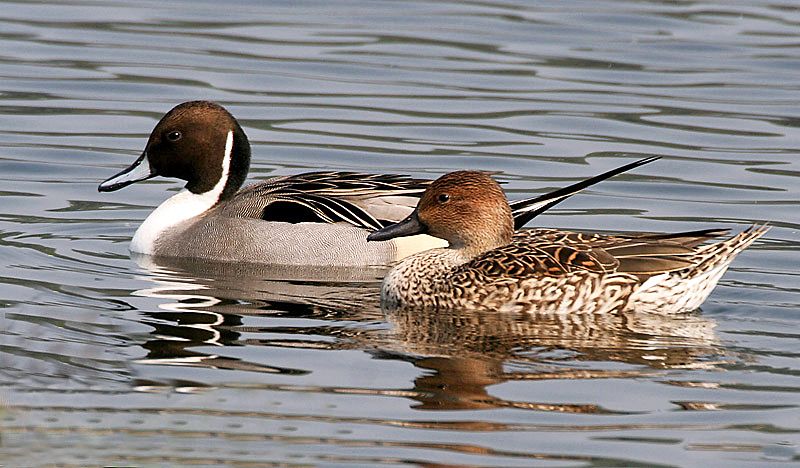
The pintail or northern pintail is a species of duck that can be found in a wide range of habitats across the world. It is native to the northern parts of Europe and the Palearctic, as well as North America.
During the breeding season, the northern pintail can be found in these northern regions, but it is a migratory species, meaning that it will migrate south to winter in more temperate climates, often reaching as far as the equator.
This allows the pintail to enjoy the best of both worlds, taking advantage of the food and resources available in the north during the breeding season, and the milder temperatures of the south during the winter.
Thus, its geographical distribution is vast, and it is able to take advantage of a wide range of environments and resources.
| Kingdom | Animalia |
| Phylum | Chordata |
| Class | Aves |
| Order | Anseriformes |
| Family | Anatidae |
| Genus | Anas |
| Species | A. acuta |
8. Tufted Duck
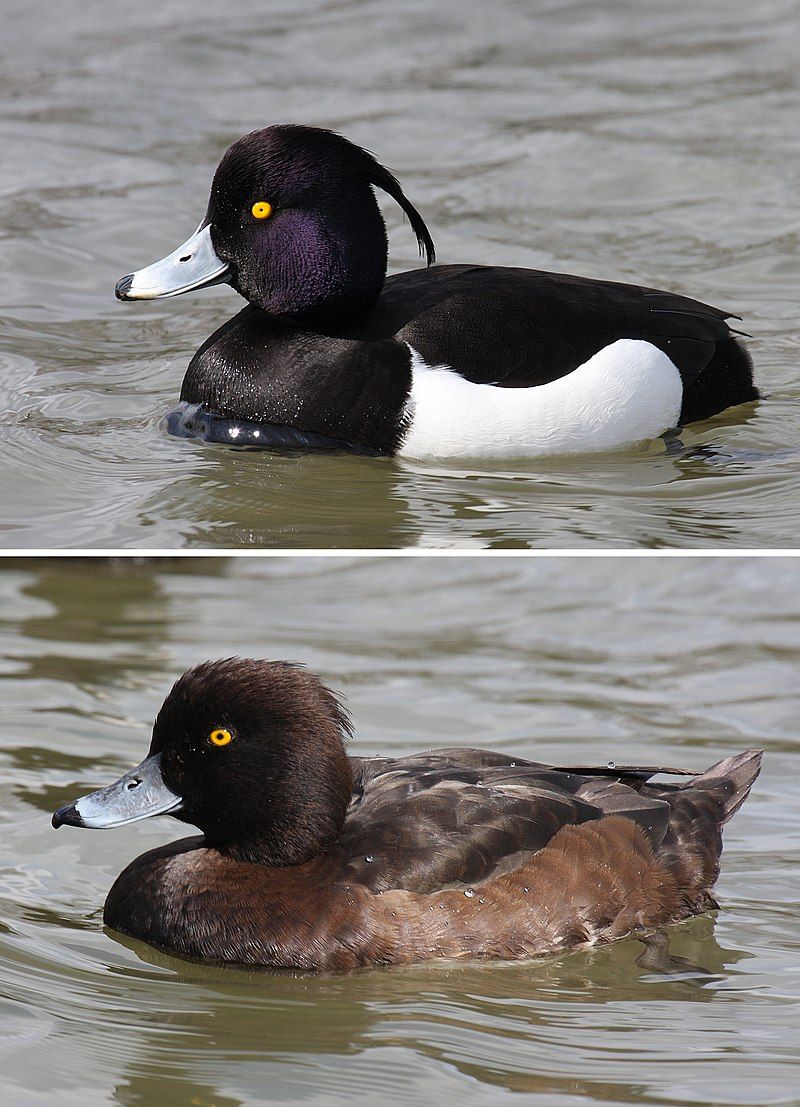
The Tufted Duck, also known as the Tufted Pochard, is a species of small diving duck that is native to Northern Eurasia. This species is estimated to have a population of close to one million birds.
It has the scientific name Aythya fuligula, which is derived from Ancient Greek and Latin roots. The root aithuia is an unidentified seabird mentioned by several authors, including Hesychius and Aristotle.
The Latin words fuligo and gula mean “soot” and “throat” respectively, which refers to the dark plumage on the throat of the Tufted Duck. This species of duck is a dabbling duck, meaning that they prefer to feed by tipping up in the water rather than diving.
They are usually seen in small groups or pairs and often congregate in large flocks with other species of dabbling ducks. They have a unique, glossy-green head with a large white spot on the forehead, and a purple-black breast and neck.
The Tufted Duck is a relatively shy species, but can be quite vocal during the breeding season. The Tufted Duck is an important species for the conservation of wetland habitats.
It is listed on the IUCN Red List as a species of least concern, but its population is still declining due to the degradation of wetland habitats. It is also hunted for sport in some countries and is threatened by the introduction of non-native species.
Conservation efforts for this species include habitat protection, reducing hunting, and reintroducing native species to their original habitats.
| Kingdom | Animalia |
| Phylum | Chordata |
| Class | Aves |
| Order | Anseriformes |
| Family | Anatidae |
| Genus | Aythya |
| Species | A. fuligula |
9. Mute Swan
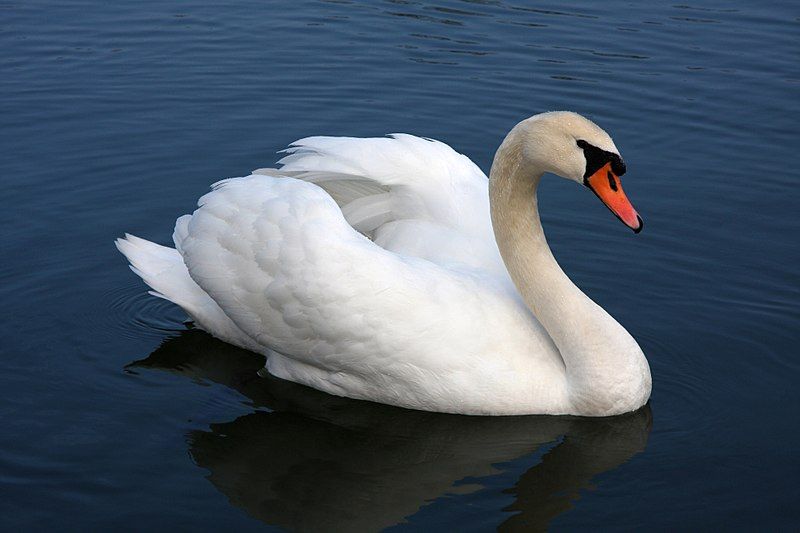
The mute swan is a species of swan found in many parts of the world, including Eurasia and the far north of Africa. It is a member of the waterfowl family Anatidae, which also includes ducks, geese, and swans.
The mute swan is known as one of the largest and heaviest waterfowl species, with an average weight of 15-25 pounds and a wingspan of up to 7 feet.
It has white plumage, black bill, and orange legs and feet. The mute swan is known to be highly territorial and will aggressively defend its territory against intruders, making it a formidable opponent to any animal or bird that strays too close.
It is also known to be quite vocal, making loud honking and hissing noises. While its name suggests that it is mute, this is not the case.
The name “mute swan” is derived from the fact that it is less vocal than other species of swans. The mute swan is found throughout much of Europe and the far north of Africa. It prefers shallow, slow-moving water bodies such as lakes, ponds, and marshes.
It feeds on aquatic plants, mollusks, and small fish. Due to its large size and aggressive behavior, the mute swan is often considered a pest by farmers and fishermen.In many parts of the world, the mute swan is a protected species due to its importance in the local ecology.
It is an important part of many wetland ecosystems, as it feeds on plants and helps to keep the aquatic environment healthy. Furthermore, its presence in an area can boost tourism, as this species is often seen as a symbol of beauty and grace.
| Kingdom | Animalia |
| Phylum | Chordata |
| Class | Aves |
| Order | Anseriformes |
| Family | Anatidae |
| Genus | Cygnus |
| Species | C. olor |
10. Red-crested Pochard
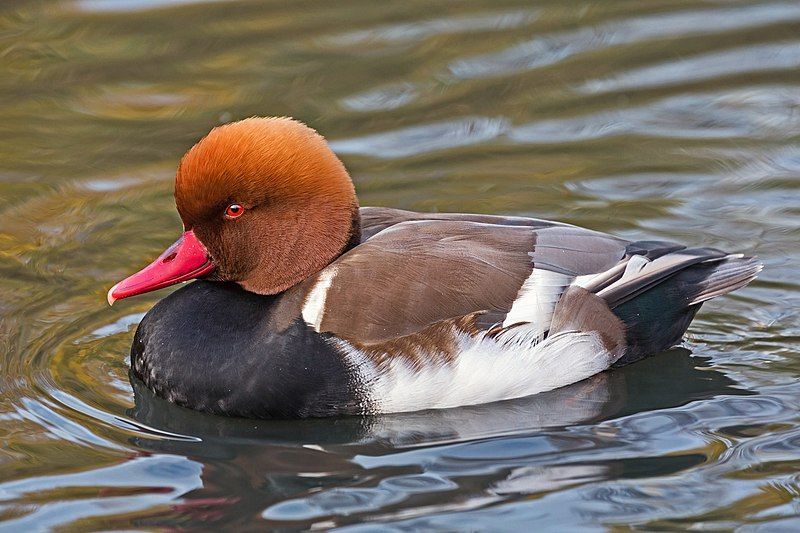
The red-crested pochard is a large, distinctive diving duck that can be found in freshwater habitats around the world. Its scientific name is derived from two different languages: Netta, which is Greek for “duck”, and Rufina, which is Latin for “golden-red”.
This is a fitting name for the species since its head is covered in a golden-red crest of feathers, making it easily recognizable even from a distance. The red-crested pochard is a large species, with a wingspan of up to one meter and a body length of up to 60 cm.
It is also a strong swimmer, with webbed feet that help it to dive into the water for food. Its diet consists of aquatic invertebrates, seeds, and plant material.
The species is also known to feed in large flocks, making it a highly visible presence in its natural habitats. The red-crested pochard is a species of conservation concern due to its declining population numbers in some areas.
This is largely attributed to habitat loss and degradation, as well as hunting and climate change. As such, the species is listed as vulnerable on the IUCN Red List of Threatened Species.
Conservation efforts are currently underway to help protect the species and its habitats, with the goal of ensuring the species’ long-term survival.
| Kingdom | Animalia |
| Phylum | Chordata |
| Class | Aves |
| Order | Anseriformes |
| Family | Anatidae |
| Genus | Netta |
| Species | N. rufina |
11. Eurasian Wigeon
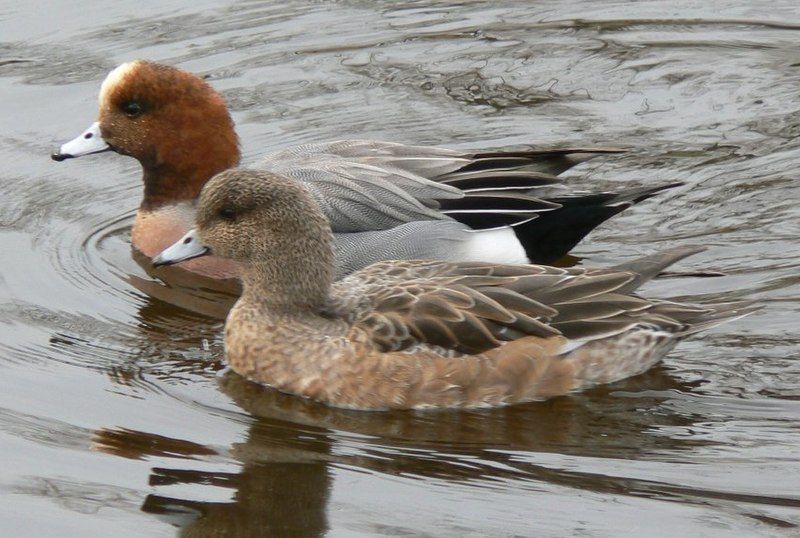
The Eurasian wigeon, also called the European wigeon, widgeon, or wigeon, is a species of dabbling duck found in the Palearctic region. It is part of the genus Mareca, which includes three species of wigeon.
The Eurasian wigeon is common and widespread throughout its range, which stretches from Eastern Europe to western Siberia and across parts of North Africa. It is a medium-sized duck, with a chestnut-brown head, white breast, and gray body.
The species is easily recognizable due to its distinctive white patch on its forehead. The Eurasian wigeon feeds mostly on aquatic vegetation, such as pond weeds, grasses, and sedges. It is often seen in shallow water, where it dives and upends to feed on the bottom.
The Eurasian wigeon is a gregarious species, often seen in large flocks on wetlands, lakes, and ponds. It is also a popular game bird, hunted for its meat and feathers.
| Kingdom | Animalia |
| Phylum | Chordata |
| Class | Aves |
| Order | Anseriformes |
| Family | Anatidae |
| Genus | Mareca |
| Species | M. penelope |
12. Gadwall
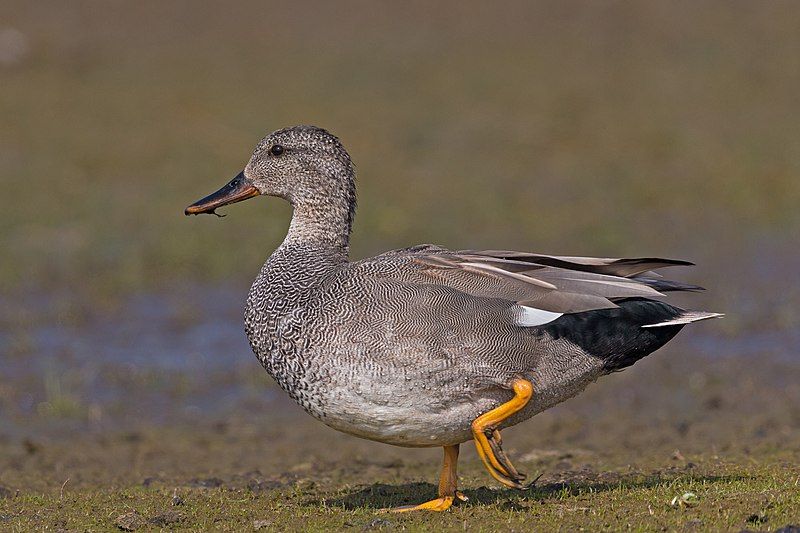
The gadwall is a species of duck that belongs to the family Anatidae. It is a dabbling duck, which means that it obtains its food by upending and tipping its body into the water.
It is found in many parts of the world, from Europe to North America, and is one of the most widespread species of dabbling duck. The gadwall has a unique plumage, with a yellow bill, grey head, and chestnut-brown wings.
Its body is light brown, and it also has a white patch on its wings. It is a medium-sized duck, about 20-25 inches in length and weighing around 2-3 pounds. The gadwall is a gregarious species, usually found in large flocks.
They are usually seen in wetlands such as marshes, ponds, and lakes, where they feed on aquatic plants, seeds, and insects.
They are also found in open fields, where they feed on grasses and other plant material. The gadwall is an important species for hunters, as it is one of the most widely hunted ducks in North America.
Its meat is highly sought after, and it is also popular in many dishes. The gadwall is a common and widespread species, and it plays an important role in the health of the ecosystems where it lives.
It helps to control populations of aquatic plants and insects, and it also provides an important food source for other species.
| Kingdom | Animalia |
| Phylum | Chordata |
| Class | Aves |
| Order | Anseriformes |
| Family | Anatidae |
| Genus | Mareca |
| Species | M. strepera |
13. Garganey
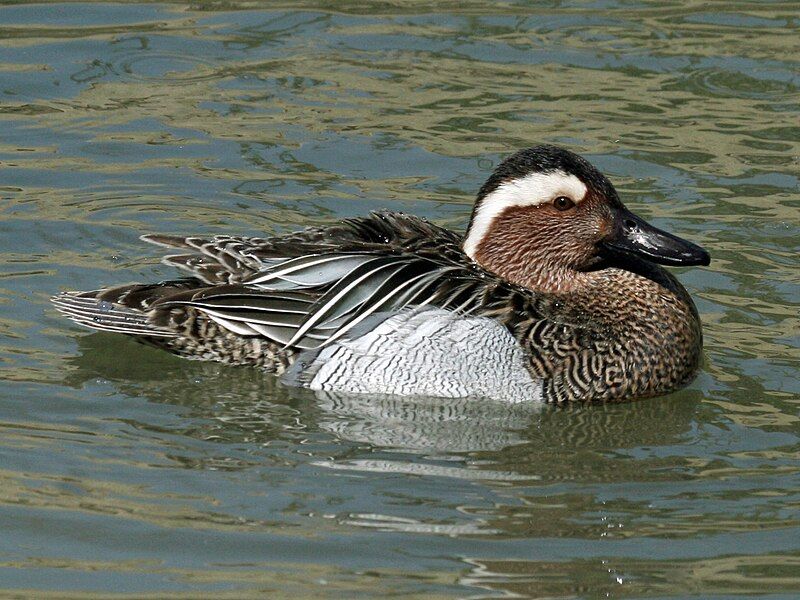
The garganey is a small dabbling duck found across much of Europe and the Palearctic region. Despite its wide distribution, it is a strictly migratory species, with the entire population migrating south during the winter months of the Northern Hemisphere.
The wintering grounds of the garganey include southern Africa, India, Bangladesh, and Australasia, where it can form large flocks. During the warmer months, the garganey returns back to Europe and the Palearctic to breed.
The garganey is an important species for both recreational hunting and as a food source and is therefore managed and monitored in many parts of its range.
| Kingdom | Animalia |
| Phylum | Chordata |
| Class | Aves |
| Order | Anseriformes |
| Family | Anatidae |
| Genus | Spatula |
| Species | S. querquedula |
14. Common Pochard
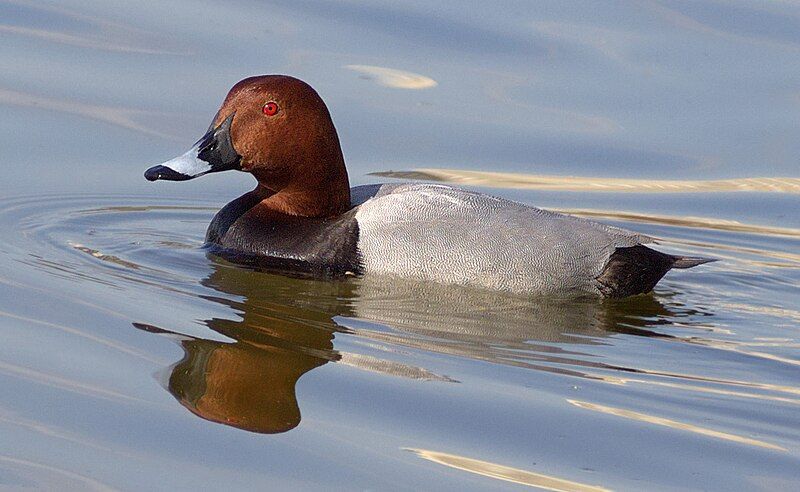
The common pochard is a medium-sized diving duck that can be found in several regions of the world. Its scientific name, Aythya ferina, is derived from the ancient Greek language.
The first part of the name, Aythya, is believed to have been taken from the words of Hesychius and Aristotle, who both mentioned an unidentified seabird in their writings. The second part of the name, ferina, is derived from the Latin word fetus, which means “wild”.
This is likely because the common pochard lives in the wild and cannot be found in domesticated environments. Overall, the scientific name of the common pochard, Aythya ferina, serves to accurately describe the species, giving insight into its natural habitat and behaviors.
| Kingdom | Animalia |
| Phylum | Chordata |
| Class | Aves |
| Order | Anseriformes |
| Family | Anatidae |
| Genus | Aythya |
| Species | A. ferina |
15. Ferruginous Duck
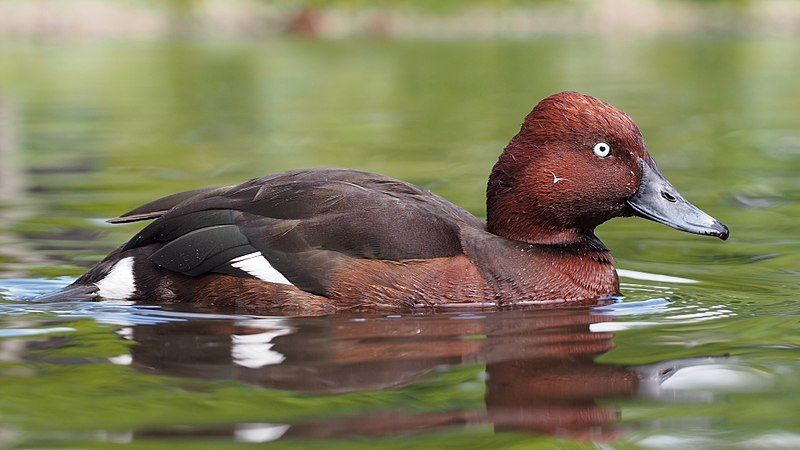
The ferruginous duck, also known as ferruginous pochard, common white-eye or white-eyed pochard, is a medium-sized diving duck native to Eurosiberia.
It is named after the Greek word Aithuia, which is a phrase used by writers such as Hesychius and Aristotle to refer to an unknown seabird.
The scientific name of the duck is derived from the Greek aithuia and the Russian word nyrok, which is the Russian word for duck. The ferruginous duck is typically brown or reddish-brown in color and has a white eye.
Its wings are short and pointed, and its feet are webbed for efficient swimming. Unlike other diving ducks, the ferruginous duck does not migrate and prefers to remain in its native range.
The ferruginous duck feeds on aquatic plants, small fish, worms, and mollusks. The ferruginous duck is an endangered species due to habitat loss, hunting, and pollution.
To help their population, many conservation efforts have been put in place, including the protection of wetlands and the creation of artificial nesting sites. It is also important to educate the public about the importance of protecting these ducks and their habitats.
With the right efforts, the population of ferruginous ducks can be preserved and allowed to flourish.
| Kingdom | Animalia |
| Phylum | Chordata |
| Class | Aves |
| Order | Anseriformes |
| Family | Anatidae |
| Genus | Aythya |
| Species | A. nyroca |
16. Gruidae
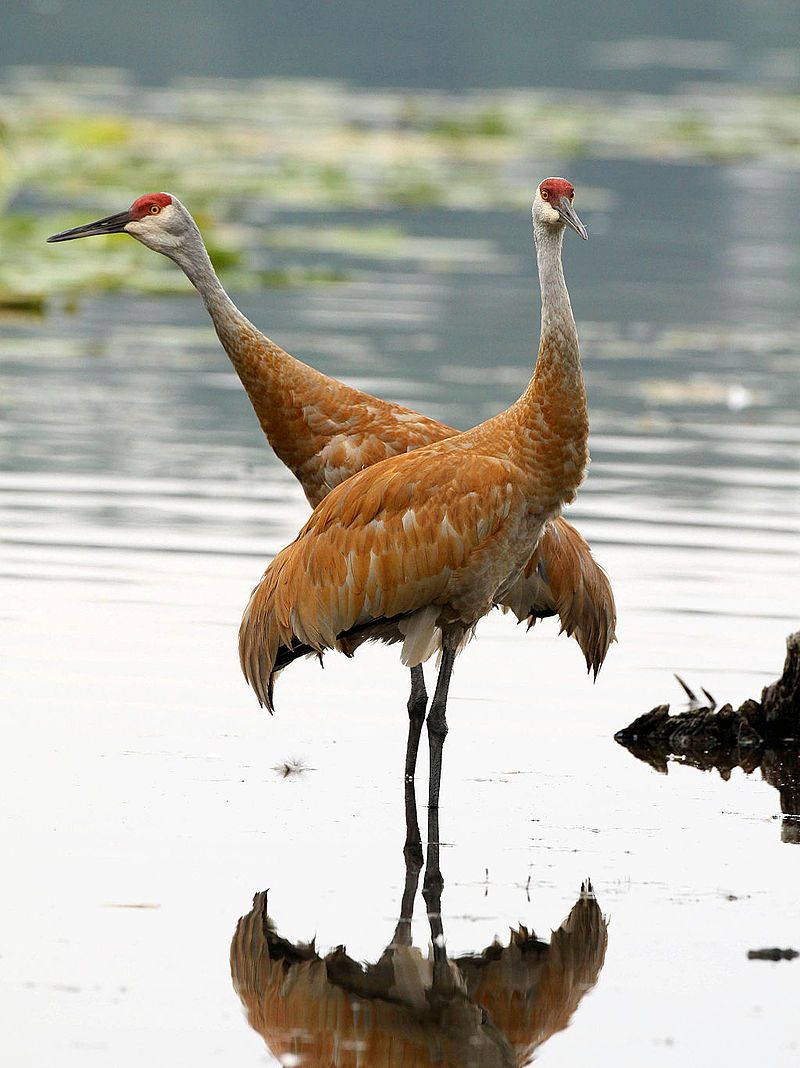
Cranes are a family of birds known as the Gruidae. They are large, with long legs and necks, and are part of the Gruiformes group. There are 15 species of cranes which are divided into three genera: Antigone, Balearica, and Grus.
They look similar to herons, but they are not related and have a few distinguishing characteristics. One difference is in flight; while herons fly with their necks pulled back, cranes fly with their necks outstretched.
This is a physical trait that helps them spot potential food sources while they soar in the sky. Cranes also have a wide wingspan which enables them to cover large distances when they migrate. Furthermore, their strong legs and feet allow them to dig for food and build nests.
| Kingdom | Animalia |
| Phylum | Chordata |
| Class | Aves |
| Order | Gruiformes |
| Family | Gruidae |
17. Water Rail
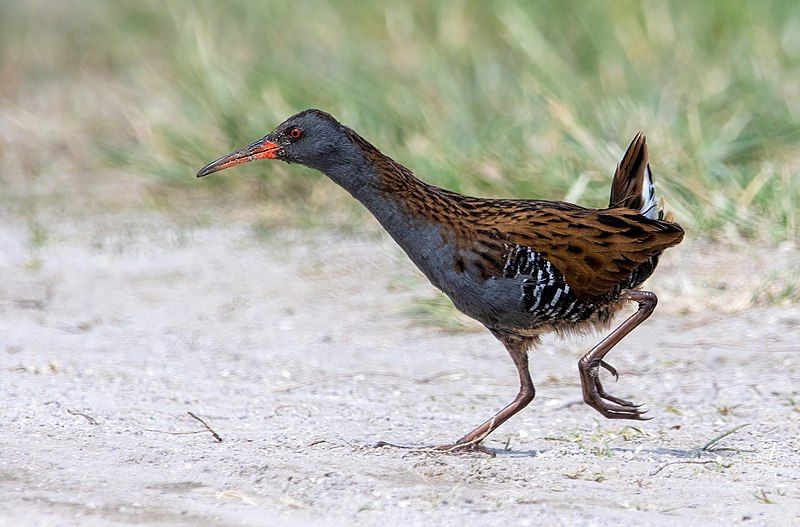
The water rail is a species of bird that belongs to the rail family. It is found across a wide range of habitats, from Europe to North Africa and Asia, and is considered to be quite adaptable.
In the northern and eastern areas of its range, the water rail is migratory, meaning that it will move to more favorable climates during the winter months. However, in the warmer parts of its breeding range, it tends to stay and remain a permanent resident.
This species prefers wetland areas that are well vegetated, as this provides ample food sources and hiding places. It is an elusive bird, often hiding in the tall grasses and reeds that line the edges of wetlands, making it difficult to spot.
It is usually seen singly, or in pairs, and is most active during the morning and evening.
| Kingdom | Animalia |
| Phylum | Chordata |
| Class | Aves |
| Order | Gruiformes |
| Family | Rallidae |
| Genus | Rallus |
| Species | R. aquaticus |
18. Common Shelduck
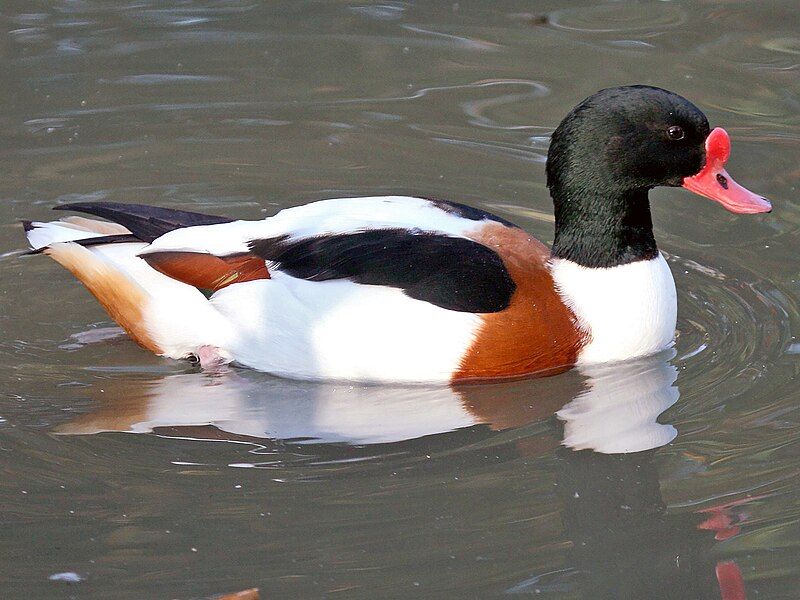
The common shelduck is a species of waterfowl that belongs to the Tadorna genus. This species is widely distributed throughout the Euro-Siberian region in the Palearctic and primarily breeds in temperate habitats.
During the winter months, common shelducks may migrate to subtropical regions, or even to the Maghreb region in North Africa. This species is very common in the habitats in which it inhabits, making it an important species for the local ecology.
Common shelducks are relatively large waterfowl, with males typically being larger than females. These birds have a wide range of coloration, ranging from white to black with patches of grey or brown. They also have a distinct white stripe on their wings.
The common shelduck is a social species, often seen in large flocks. They are typically seen on coasts, lakes, or even in estuaries, where they feed on crustaceans, insects, mollusks, and other aquatic invertebrates.
Common shelducks are also known to be monogamous, and pairs typically stay together for the duration of the breeding season. During this time, the male will display courtship behavior to attract a mate, and the female will build a nest, usually in a hollow tree or bush.
She will then lay a clutch of 7-12 eggs, which will be incubated by both parents for a period of 28 days. Once the chicks have hatched, the parents will take turns feeding and caring for them until they are ready to leave the nest.
| Kingdom | Animalia |
| Phylum | Chordata |
| Class | Aves |
| Order | Anseriformes |
| Family | Anatidae |
| Genus | Tadorna |
| Species | T. tadorna |
19. Common Crane
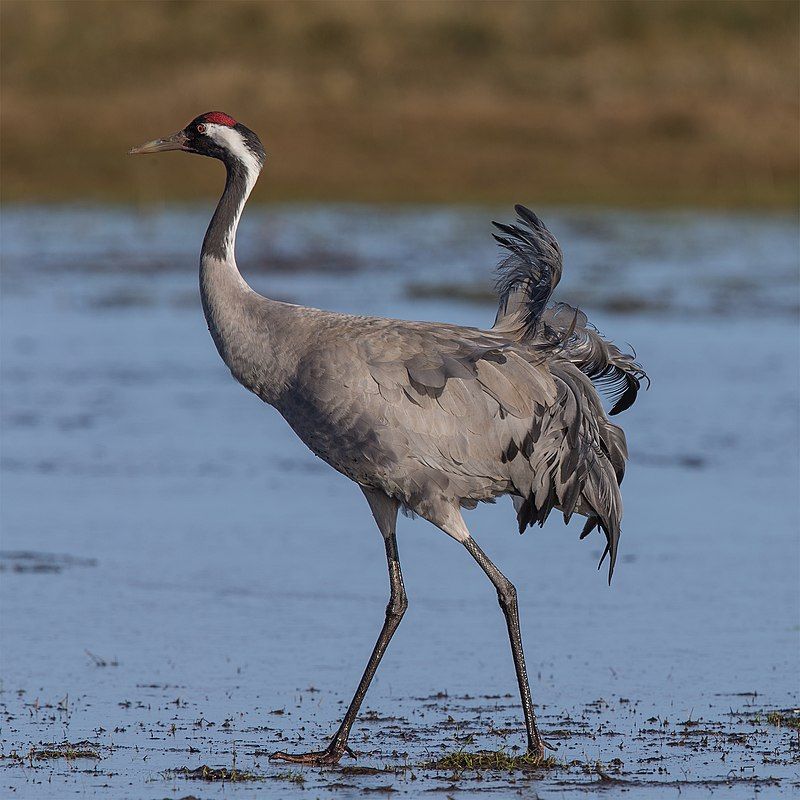
The common crane, also known as the Eurasian crane, is a bird found in the family Gruidae, cranes. It is considered a medium-sized bird, with a wingspan of approximately 1.5 meters.
It is the most commonly found crane species in Europe, aside from the demoiselle crane and the Siberian crane.
The demoiselle crane is a smaller species, found in the western parts of Europe, while the Siberian crane is a rare species found in the far eastern parts of the continent.
The common crane inhabits wetlands and open grasslands, where it typically feeds on insects, small mammals, and grains. It is an iconic species in Europe and is a symbol of good luck and fortune.
It is also an important species for conservation, as its population is declining due to habitat loss and other human activities. In order to protect the species, conservation efforts have been made in Europe, and the species is now a protected species in many countries.
| Kingdom | Animalia |
| Phylum | Chordata |
| Class | Aves |
| Order | Gruiformes |
| Family | Gruidae |
| Genus | Grus |
| Species | G. grus |
20. Common Pheasant
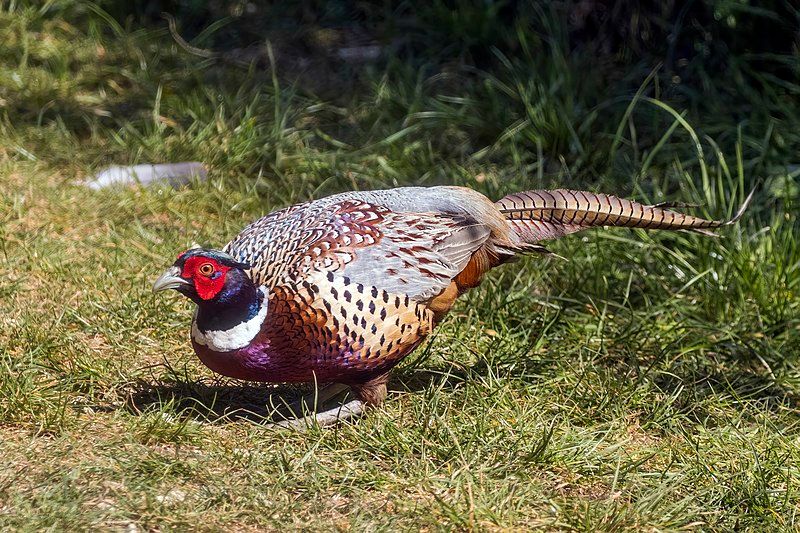
The common pheasant is a type of bird that belongs to the pheasant family. Its name originates from the Latin word ‘Phasianus’, which translates to mean ‘pheasant’.
The species of the pheasant, colchicus, is derived from the Latin word ‘Colchis’, which is a country located on the Black Sea. This is where pheasants were first known to Europeans.
This type of bird is typically brown in color, with a long tail and a crest of feathers on its head. It is also known for its loud call, which is a series of short, raspy notes. The common pheasant is found in many parts of the world, including Europe, Asia, and North America.
They usually inhabit open areas such as meadows, fields, and grasslands, where they can forage for food. Pheasants are omnivorous, eating a variety of seeds, insects, and small animals. They are also known to eat berries and fruits.
They are a popular game bird and are regularly hunted for sport.
| Kingdom | Animalia |
| Phylum | Chordata |
| Class | Aves |
| Order | Galliformes |
| Family | Phasianidae |
| Genus | Phasianus |
| Species | P. colchicus |
21. Rail
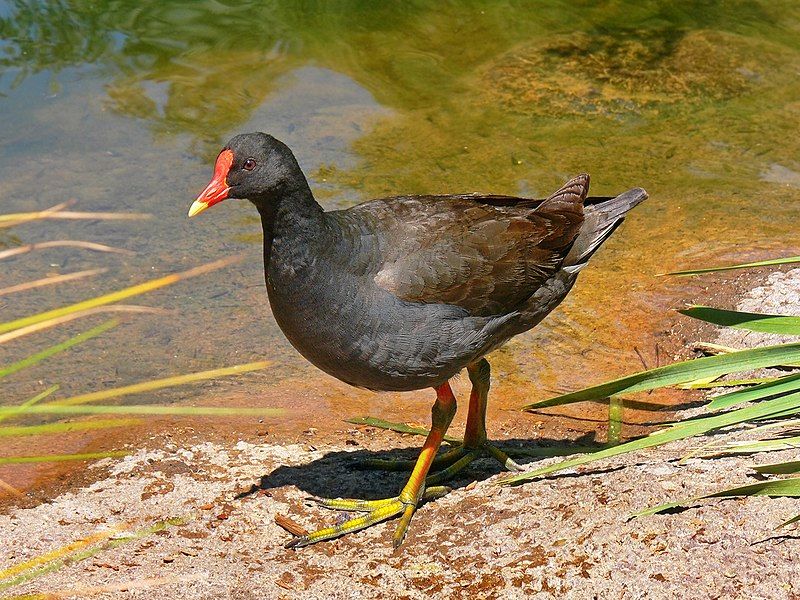
Rails are a very diverse family of birds that can be found in many different habitats around the world. They vary in size from small to medium and live either on land or in wetlands.
One of the most common rail species is the crake, which can be seen in many different environments. Coots and gallinules are also common and can be found in many different areas.
However, some rail species are very rare or even endangered, and may only be found in isolated areas. In general, rails are an important part of the ecosystem, providing food for other animals and helping to keep wetlands healthy.
| Kingdom | Animalia |
| Phylum | Chordata |
| Class | Aves |
| Order | Gruiformes |
| Family | Rallidae |
22. Black-winged Stilt
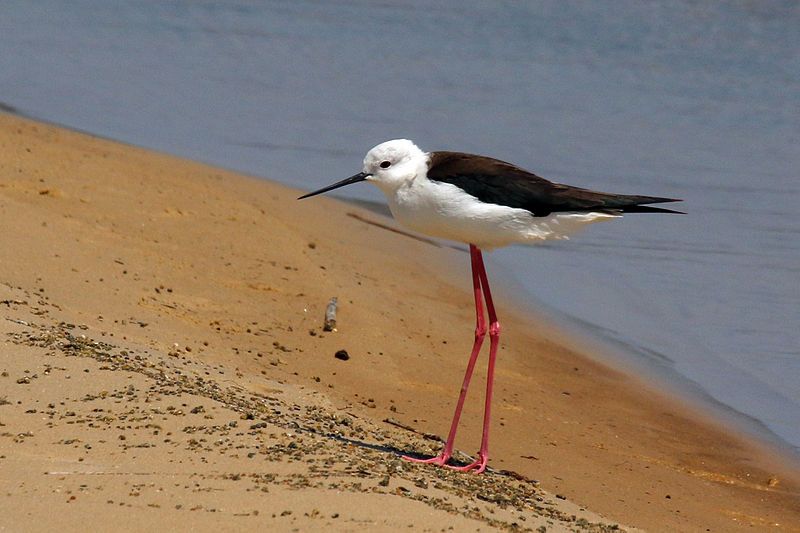
The black-winged stilt is a species of wading bird belonging to the avocet and stilt family, whose scientific name is Himantopus himantopus.
This species is widely distributed across the world and can be found in various habitats, such as wetlands, coastal regions, and inland lakes. It is a highly recognizable bird due to its distinctive long legs.
The black-winged stilt has a wingspan of up to 1.5 meters and is typically found foraging in shallow water, where it is able to detect small aquatic prey. Its cosmopolitan range has made the black-winged stilt one of the most widespread of all wading birds, and its scientific name Himantopus himantopus is sometimes used to refer to a single, almost cosmopolitan species.
This species has been known to inhabit many regions across the world, from the Mediterranean to East Asia, and from southern Africa to Australia.
It is also known to migrate seasonally to more hospitable environments, such as wetlands and coastal areas. The black-winged stilt can be identified by its black wings, white body, and long red legs. It has a slightly upturned bill, which it uses to pick up small aquatic prey.
The stilt is generally a solitary feeder but can be found in small groups during the breeding season.
It is a vocal bird, making loud calls during the day, and even more so during the night. In recent years, the black-winged stilt population has seen a decline due to human disturbance, habitat destruction, and pollution.
Conservation efforts are in place to protect this species, and its habitat, in order to secure its future.
| Kingdom | Animalia |
| Phylum | Chordata |
| Class | Aves |
| Order | Charadriiformes |
| Family | Recurvirostridae |
| Genus | Himantopus |
| Species | H. himantopus |
23. Alpine Swift
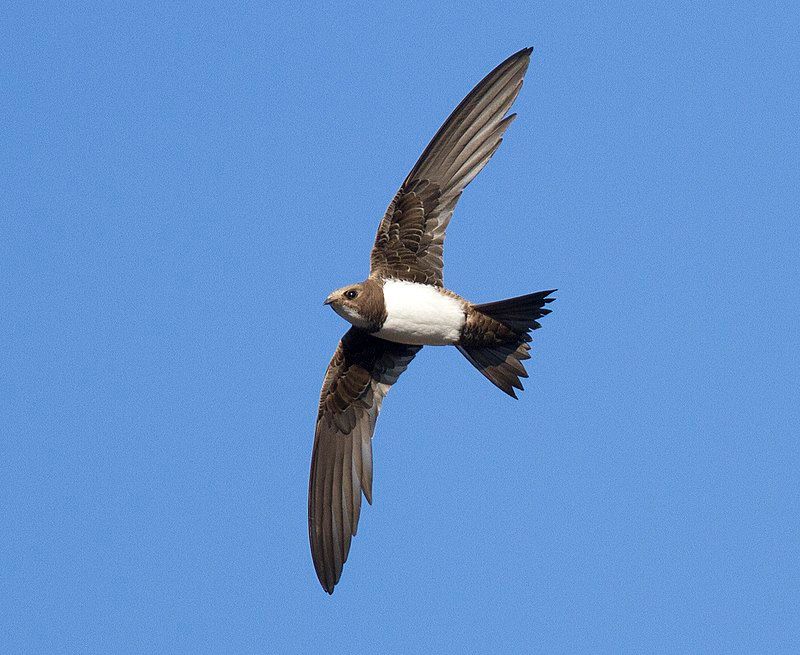
The alpine swift is a species of swift that can be found in Africa, southern Europe, and Asia. It is a migratory bird, which means it moves from place to place to find food and suitable places to breed.
Alpine swifts breed in mountains, ranging from southern Europe to the Himalayas. During the winter months, the population of alpine swifts in southern Europe moves further south to winter in southern Africa.
This species of swift is similar to common swifts in that they are migratory. However, they can tolerate colder temperatures and they breed in mountainous areas. They also tend to have a longer wingspan than other swifts.
The alpine swift is an important species that helps to maintain the balance of nature in its habitats.
| Kingdom | Animalia |
| Phylum | Chordata |
| Class | Aves |
| Clade | Strisores |
| Order | Apodiformes |
| Family | Apodidae |
| Genus | Tachymarptis |
| Species | T. melba |
24. White Stork
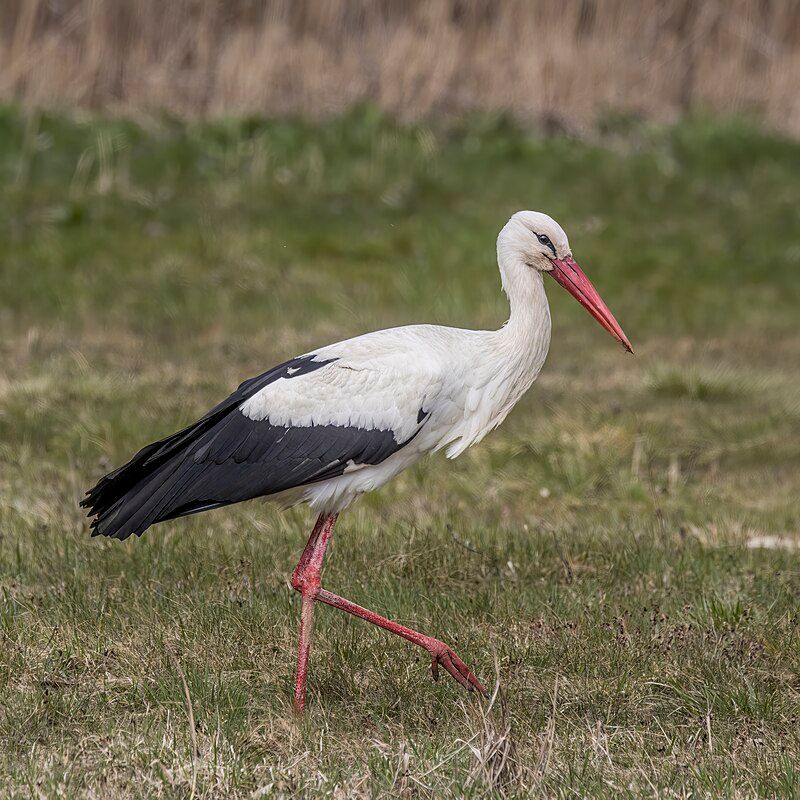
The white stork is a majestic bird that belongs to the Ciconiidae family of storks. It is easily identifiable by its large size and distinctive white plumage. The feathers on its wings are black, which helps to contrast the white body.
Adult white storks have long, bright red legs and beaks, and measure an average of 100-115 centimeters from beak to tail. Their wingspan is even larger, ranging from 155-215 centimeters.
The impressive wingspan helps the bird traverse long distances during its migratory journeys. This bird is a magnificent sight to behold, with its white feathers, long legs, and elegant wings.
| Kingdom | Animalia |
| Phylum | Chordata |
| Class | Aves |
| Order | Ciconiiformes |
| Family | Ciconiidae |
| Genus | Ciconia |
| Species | C. ciconia |
Conclusion
Birds in Parma are a vital part of the local environment, providing beauty, song, food, and other benefits to the city. They are an important part of the local ecosystem, and their presence is essential for the health of both the human and natural environment.
Parma has an impressive variety of birds, and their presence adds to the diversity of the city’s natural wonders. With the proper protection, Parma’s bird population will continue to thrive for years to come.